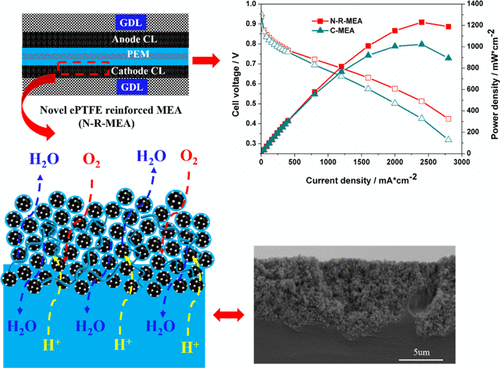当前位置:
X-MOL 学术
›
ACS Sustain. Chem. Eng.
›
论文详情
Our official English website, www.x-mol.net, welcomes your
feedback! (Note: you will need to create a separate account there.)
A Novel Approach to Fabricate Membrane Electrode Assembly by Directly Coating the Nafion Ionomer on Catalyst Layers for Proton-Exchange Membrane Fuel Cells
ACS Sustainable Chemistry & Engineering ( IF 7.1 ) Pub Date : 2020-06-11 , DOI: 10.1021/acssuschemeng.0c02386
Cheng Yang 1, 2 , Ning Han 3 , Yajun Wang 2, 3 , Xiao-Zi Yuan 4 , Jiaoyan Xu 1, 2 , Henghui Huang 1, 2 , Jiantao Fan 1, 2, 5 , Hui Li 1, 2 , Haijiang Wang 2, 3
ACS Sustainable Chemistry & Engineering ( IF 7.1 ) Pub Date : 2020-06-11 , DOI: 10.1021/acssuschemeng.0c02386
Cheng Yang 1, 2 , Ning Han 3 , Yajun Wang 2, 3 , Xiao-Zi Yuan 4 , Jiaoyan Xu 1, 2 , Henghui Huang 1, 2 , Jiantao Fan 1, 2, 5 , Hui Li 1, 2 , Haijiang Wang 2, 3
Affiliation

|
The fabrication art of the membrane electrode assembly (MEA) in a proton-exchange membrane (PEM) fuel cell strongly correlates to the cell performance. It has been recognized that defects, for example, high interfacial resistance between the catalyst layers (CLs) and the membrane or cracks in the CLs, may occur during the MEA manufacturing process. These defects could greatly influence the electrochemical performance of the fuel cell. To eliminate those defects and improve the cell performance, in this study, a novel fabrication approach of the MEA for PEM fuel cells is developed. With this method, the Nafion ionomer, employed as a PEM, is directly coated onto both the cathode and anode CLs. As a result, not only an excellent interfacial connection between the PEM and CLs is achieved with a low interfacial resistance, but also cracks are eliminated due to Nafion ionomer penetration into the cracks, forming hydrophilic channels with ionic conduction. Those ionic conduction channels improve the water management, lower the mass transport loss, and facilitate the proton transfer, thus maximizing the three-phase boundary and enhancing the utilization of Pt/C catalysts. By adding an expanded polytetrafluoroethylene film, a favorable mechanical property of the MEA is also achieved. This novel MEA exhibits excellent cell performance under low humidity conditions. Under the H2/air operation, the cell performance reaches a high maximum power density of 1.35 W cm–2.
中文翻译:

通过在质子交换膜燃料电池的催化剂层上直接涂覆Nafion离聚物来制造膜电极组件的新方法
质子交换膜(PEM)燃料电池中的膜电极组件(MEA)的制造工艺与电池性能密切相关。已经认识到在MEA制造过程中可能发生缺陷,例如催化剂层(CL)和膜之间的高界面电阻或CL中的裂缝。这些缺陷会极大地影响燃料电池的电化学性能。为了消除这些缺陷并改善电池性能,在这项研究中,开发了一种用于PEM燃料电池的MEA的新颖制造方法。用这种方法,将用作PEM的Nafion离聚物直接涂覆在阴极和阳极CL上。结果,不仅以低的界面电阻实现了PEM和CL之间的出色的界面连接,但是由于Nafion离聚物渗透到裂缝中而形成的亲水性通道具有离子传导性,因此裂缝也得以消除。这些离子传导通道改善了水的管理,降低了质量传递损失,并促进了质子的转移,从而最大化了三相边界并提高了Pt / C催化剂的利用率。通过添加膨胀的聚四氟乙烯膜,还可以获得MEA的良好的机械性能。这种新颖的MEA在低湿度条件下显示出出色的电池性能。在H下 因此最大化了三相边界并提高了Pt / C催化剂的利用率。通过添加膨胀的聚四氟乙烯膜,还可以获得MEA的良好的机械性能。这种新颖的MEA在低湿度条件下显示出出色的电池性能。在H下 因此最大化了三相边界并提高了Pt / C催化剂的利用率。通过添加膨胀的聚四氟乙烯膜,还可以获得MEA的良好的机械性能。这种新颖的MEA在低湿度条件下显示出出色的电池性能。在H下2 /空气操作时,电池性能达到1.35 W cm –2的高最大功率密度。
更新日期:2020-07-06
中文翻译:

通过在质子交换膜燃料电池的催化剂层上直接涂覆Nafion离聚物来制造膜电极组件的新方法
质子交换膜(PEM)燃料电池中的膜电极组件(MEA)的制造工艺与电池性能密切相关。已经认识到在MEA制造过程中可能发生缺陷,例如催化剂层(CL)和膜之间的高界面电阻或CL中的裂缝。这些缺陷会极大地影响燃料电池的电化学性能。为了消除这些缺陷并改善电池性能,在这项研究中,开发了一种用于PEM燃料电池的MEA的新颖制造方法。用这种方法,将用作PEM的Nafion离聚物直接涂覆在阴极和阳极CL上。结果,不仅以低的界面电阻实现了PEM和CL之间的出色的界面连接,但是由于Nafion离聚物渗透到裂缝中而形成的亲水性通道具有离子传导性,因此裂缝也得以消除。这些离子传导通道改善了水的管理,降低了质量传递损失,并促进了质子的转移,从而最大化了三相边界并提高了Pt / C催化剂的利用率。通过添加膨胀的聚四氟乙烯膜,还可以获得MEA的良好的机械性能。这种新颖的MEA在低湿度条件下显示出出色的电池性能。在H下 因此最大化了三相边界并提高了Pt / C催化剂的利用率。通过添加膨胀的聚四氟乙烯膜,还可以获得MEA的良好的机械性能。这种新颖的MEA在低湿度条件下显示出出色的电池性能。在H下 因此最大化了三相边界并提高了Pt / C催化剂的利用率。通过添加膨胀的聚四氟乙烯膜,还可以获得MEA的良好的机械性能。这种新颖的MEA在低湿度条件下显示出出色的电池性能。在H下2 /空气操作时,电池性能达到1.35 W cm –2的高最大功率密度。































 京公网安备 11010802027423号
京公网安备 11010802027423号